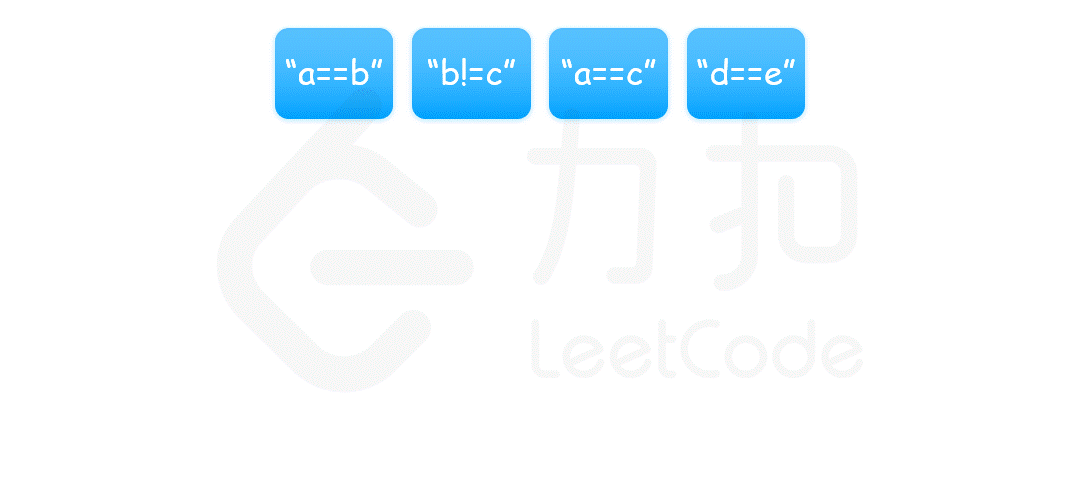原文链接: https://leetcode-cn.com/problems/satisfiability-of-equality-equations
英文原文
You are given an array of strings equations that represent relationships between variables where each string equations[i] is of length 4 and takes one of two different forms: "xi==yi" or "xi!=yi".Here, xi and yi are lowercase letters (not necessarily different) that represent one-letter variable names.
Return true if it is possible to assign integers to variable names so as to satisfy all the given equations, or false otherwise.
Example 1:
Input: equations = ["a==b","b!=a"] Output: false Explanation: If we assign say, a = 1 and b = 1, then the first equation is satisfied, but not the second. There is no way to assign the variables to satisfy both equations.
Example 2:
Input: equations = ["b==a","a==b"] Output: true Explanation: We could assign a = 1 and b = 1 to satisfy both equations.
Example 3:
Input: equations = ["a==b","b==c","a==c"] Output: true
Example 4:
Input: equations = ["a==b","b!=c","c==a"] Output: false
Example 5:
Input: equations = ["c==c","b==d","x!=z"] Output: true
Constraints:
1 <= equations.length <= 500equations[i].length == 4equations[i][0]is a lowercase letter.equations[i][1]is either'='or'!'.equations[i][2]is'='.equations[i][3]is a lowercase letter.
中文题目
给定一个由表示变量之间关系的字符串方程组成的数组,每个字符串方程 equations[i] 的长度为 4,并采用两种不同的形式之一:"a==b" 或 "a!=b"。在这里,a 和 b 是小写字母(不一定不同),表示单字母变量名。
只有当可以将整数分配给变量名,以便满足所有给定的方程时才返回 true,否则返回 false。
示例 1:
输入:["a==b","b!=a"] 输出:false 解释:如果我们指定,a = 1 且 b = 1,那么可以满足第一个方程,但无法满足第二个方程。没有办法分配变量同时满足这两个方程。
示例 2:
输入:["b==a","a==b"] 输出:true 解释:我们可以指定 a = 1 且 b = 1 以满足满足这两个方程。
示例 3:
输入:["a==b","b==c","a==c"] 输出:true
示例 4:
输入:["a==b","b!=c","c==a"] 输出:false
示例 5:
输入:["c==c","b==d","x!=z"] 输出:true
提示:
1 <= equations.length <= 500equations[i].length == 4equations[i][0]和equations[i][3]是小写字母equations[i][1]要么是'=',要么是'!'equations[i][2]是'='
通过代码
高赞题解
📺 视频题解
📖 文字题解
方法一:并查集
我们可以将每一个变量看作图中的一个节点,把相等的关系 == 看作是连接两个节点的边,那么由于表示相等关系的等式方程具有传递性,即如果 a==b 和 b==c 成立,则 a==c 也成立。也就是说,所有相等的变量属于同一个连通分量。因此,我们可以使用并查集来维护这种连通分量的关系。
首先遍历所有的等式,构造并查集。同一个等式中的两个变量属于同一个连通分量,因此将两个变量进行合并。
然后遍历所有的不等式。同一个不等式中的两个变量不能属于同一个连通分量,因此对两个变量分别查找其所在的连通分量,如果两个变量在同一个连通分量中,则产生矛盾,返回 false。
如果遍历完所有的不等式没有发现矛盾,则返回 true。
 {:width=”90%”}
{:width=”90%”}
具体实现方面,使用一个数组 parent 存储每个变量的连通分量信息,其中的每个元素表示当前变量所在的连通分量的父节点信息,如果父节点是自身,说明该变量为所在的连通分量的根节点。一开始所有变量的父节点都是它们自身。对于合并操作,我们将第一个变量的根节点的父节点指向第二个变量的根节点;对于查找操作,我们沿着当前变量的父节点一路向上查找,直到找到根节点。
[sol1-Java]class Solution { public boolean equationsPossible(String[] equations) { int[] parent = new int[26]; for (int i = 0; i < 26; i++) { parent[i] = i; } for (String str : equations) { if (str.charAt(1) == '=') { int index1 = str.charAt(0) - 'a'; int index2 = str.charAt(3) - 'a'; union(parent, index1, index2); } } for (String str : equations) { if (str.charAt(1) == '!') { int index1 = str.charAt(0) - 'a'; int index2 = str.charAt(3) - 'a'; if (find(parent, index1) == find(parent, index2)) { return false; } } } return true; } public void union(int[] parent, int index1, int index2) { parent[find(parent, index1)] = find(parent, index2); } public int find(int[] parent, int index) { while (parent[index] != index) { parent[index] = parent[parent[index]]; index = parent[index]; } return index; } }
[sol1-C++]class UnionFind { private: vector<int> parent; public: UnionFind() { parent.resize(26); iota(parent.begin(), parent.end(), 0); } int find(int index) { if (index == parent[index]) { return index; } parent[index] = find(parent[index]); return parent[index]; } void unite(int index1, int index2) { parent[find(index1)] = find(index2); } }; class Solution { public: bool equationsPossible(vector<string>& equations) { UnionFind uf; for (const string& str: equations) { if (str[1] == '=') { int index1 = str[0] - 'a'; int index2 = str[3] - 'a'; uf.unite(index1, index2); } } for (const string& str: equations) { if (str[1] == '!') { int index1 = str[0] - 'a'; int index2 = str[3] - 'a'; if (uf.find(index1) == uf.find(index2)) { return false; } } } return true; } };
[sol1-Python3]class Solution: class UnionFind: def __init__(self): self.parent = list(range(26)) def find(self, index): if index == self.parent[index]: return index self.parent[index] = self.find(self.parent[index]) return self.parent[index] def union(self, index1, index2): self.parent[self.find(index1)] = self.find(index2) def equationsPossible(self, equations: List[str]) -> bool: uf = Solution.UnionFind() for st in equations: if st[1] == "=": index1 = ord(st[0]) - ord("a") index2 = ord(st[3]) - ord("a") uf.union(index1, index2) for st in equations: if st[1] == "!": index1 = ord(st[0]) - ord("a") index2 = ord(st[3]) - ord("a") if uf.find(index1) == uf.find(index2): return False return True
[sol1-Golang]func equationsPossible(equations []string) bool { parent := make([]int, 26) for i := 0; i < 26; i++ { parent[i] = i } for _, str := range equations { if str[1] == '=' { index1 := int(str[0] - 'a') index2 := int(str[3] - 'a') union(parent, index1, index2) } } for _, str := range equations { if str[1] == '!' { index1 := int(str[0] - 'a') index2 := int(str[3] - 'a') if find(parent, index1) == find(parent, index2) { return false } } } return true } func union(parent []int, index1, index2 int) { parent[find(parent, index1)] = find(parent, index2) } func find(parent []int, index int) int { for parent[index] != index { parent[index] = parent[parent[index]] index = parent[index] } return index }
复杂度分析
时间复杂度:$O(n+C \log C)$,其中 $n$ 是
equations中的方程数量,$C$ 是变量的总数,在本题中变量都是小写字母,即 $C \leq 26$。上面的并查集代码中使用了路径压缩优化,对于每个方程的合并和查找的均摊时间复杂度都是 $O(\log C)$。由于需要遍历每个方程,因此总时间复杂度是 $O(n+C \log C)$。空间复杂度:$O(C)$。创建一个数组
parent存储每个变量的连通分量信息,由于变量都是小写字母,因此parent是长度为 $C$。
统计信息
| 通过次数 | 提交次数 | AC比率 |
|---|---|---|
| 34945 | 68906 | 50.7% |
提交历史
| 提交时间 | 提交结果 | 执行时间 | 内存消耗 | 语言 |
|---|





